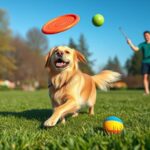If you want to keep your active pup entertained and fit, agility exercises are perfect! Start with Tunnel Runs and weave through colorful tubes. Then, set up Weave Poles and Jumping Hurdles to boost coordination and confidence. Try an A-Frame Climb for strength and balance. Tire Jumps add excitement, while Balance Beams enhance focus. For a fun challenge, create a Spiral Course and use a Pause Table to teach self-control. Introduce Seesaw Training for a rewarding experience, and finish with an Agility Ladder to refine movements. Want to learn about their benefits and how to set them up? Keep exploring!
Tunnel Runs
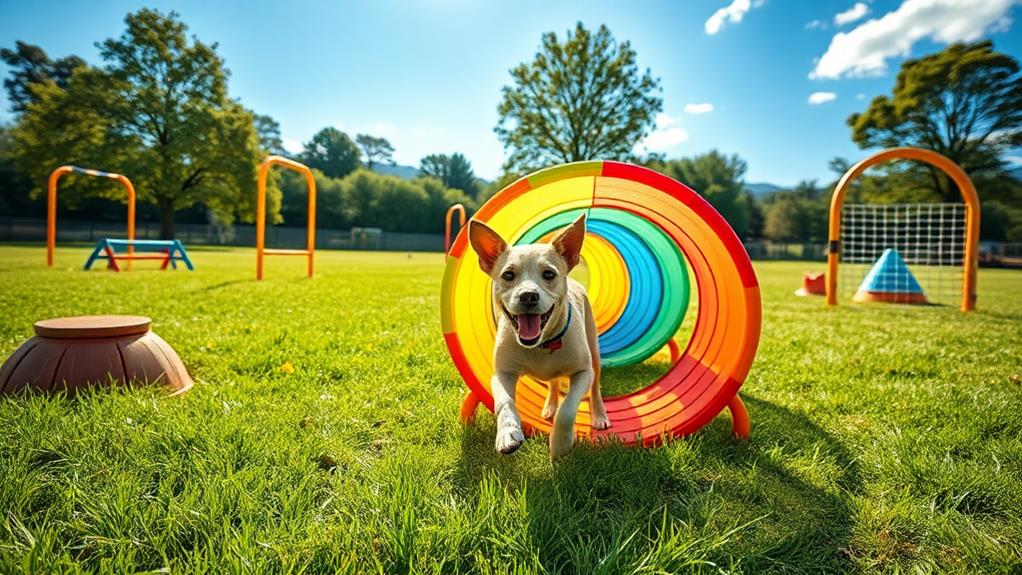
While your pup might be impatient to explore, tunnel runs provide an exciting way to channel that energy. These colorful, flexible tubes invite your dog to sprint through them, sparking their natural curiosity and enthusiasm. Setting up a tunnel is straightforward; you can purchase one or create a DIY version using household items. Just make sure it's safe and sturdy.
To get started, encourage your pup to enter the tunnel by using treats or toys as motivation. Stand at the other end and call them, creating a fun chase. As they gain confidence, you can gradually increase the length of the tunnel or add additional challenges, like twists or turns. This keeps things interesting and pushes your pup's agility skills.
Tunnel runs not only provide physical exercise but also stimulate your dog mentally. The challenge of traversing through the tunnel can help improve their focus and confidence. Plus, it's a great way for you to bond with your furry friend while having fun. So grab that tunnel and get ready for an action-packed session that'll leave your pup wagging their tail and excited for more!
Weave Poles
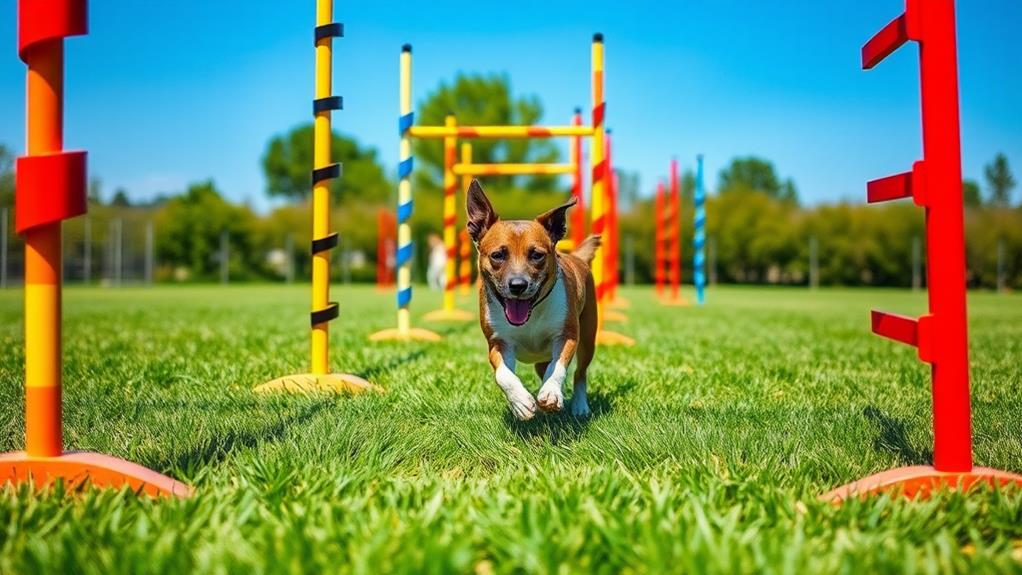
Weave poles are an excellent way to enhance your pup's agility and coordination. This exercise challenges your dog to maneuver through a series of vertical poles, which improves their balance and spatial awareness. To get started, set up a line of poles spaced evenly apart, typically about 18-24 inches.
Begin by leading your pup through the poles using a treat or their favorite toy as motivation. Encourage them to zigzag between the poles, rewarding them each time they successfully navigate a pair. Patience is key here; don't rush the process. If your pup struggles, consider using fewer poles initially to build their confidence.
As they get the hang of it, gradually increase the number of poles and try varying the spacing. This keeps the activity fresh and challenging. Remember to maintain a positive attitude and use plenty of praise, making it a fun bonding experience.
Incorporating weave poles into your dog's routine not only builds agility but also strengthens your connection. So grab those poles, and watch your pup thrive as they master this exciting skill!
Jumping Hurdles
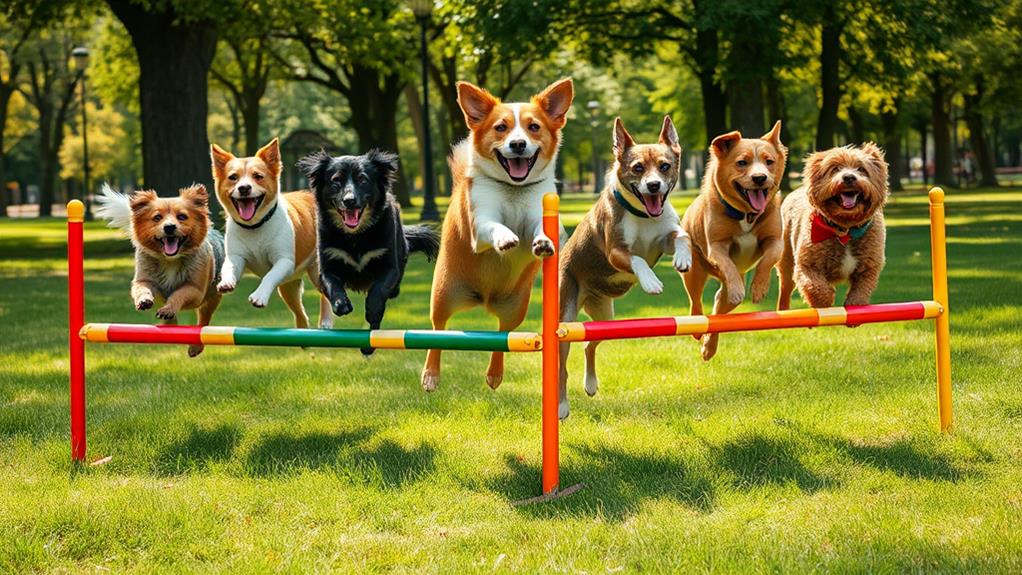
After your pup masters the weave poles, it's time to introduce jumping hurdles to their agility training. Jumping hurdles not only boosts your dog's physical strength but also enhances their coordination and confidence. Start with lower hurdles to build your pup's comfort level, gradually increasing the height as they gain experience.
Here's what to keep in mind while training:
- Choose the Right Height: Start with hurdles that are low enough for your pup to clear safely.
- Use Positive Reinforcement: Reward your dog with treats and praise for every successful jump to keep them motivated.
- Practice Consistently: Regular practice sessions help improve their technique and build muscle memory.
- Mind Their Landing: Guarantee your pup lands softly to prevent injury; consider using soft surfaces for training.
- Incorporate Variety: Mix in different jump patterns and spacing to keep training exciting and challenging.
A-Frame Climb
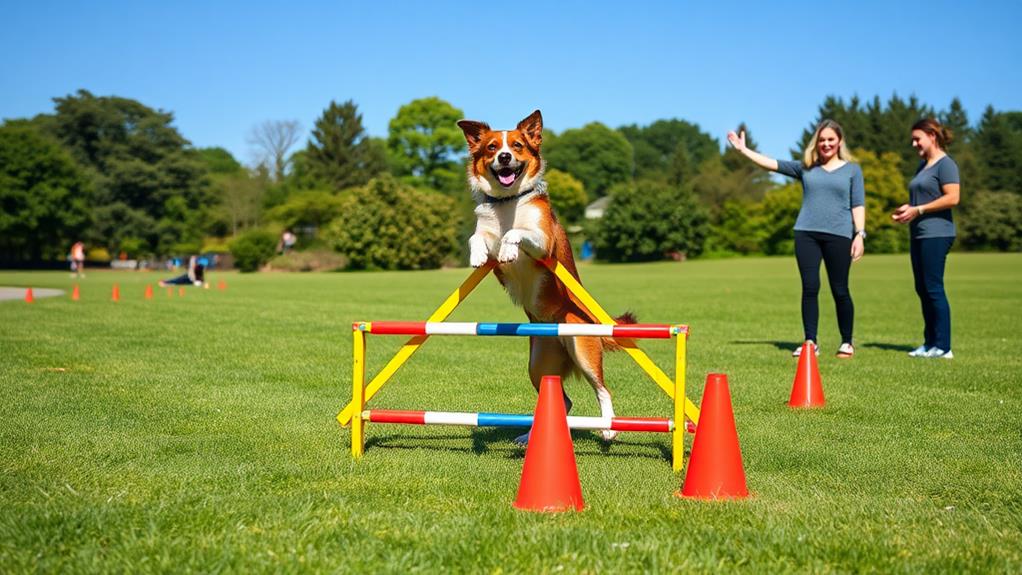
Introducing the A-Frame climb to your pup's agility routine can be an exciting challenge that markedly boosts their strength and balance. This exercise not only encourages your dog to climb but also helps develop their coordination and confidence. The A-Frame consists of two slanted surfaces that meet at a peak, creating a triangular shape.
To get started, guide your pup up the incline using treats or toys. Start with a low-height frame, gradually increasing the difficulty as your pup becomes comfortable. Always reward them for their efforts, reinforcing positive behavior.
Here's a quick overview of the A-Frame climb:
| Step | Description | Tips |
|---|---|---|
| 1. Approach | Encourage your pup to approach the A-Frame. | Use treats or toys. |
| 2. Ascend | Guide them to climb up the incline. | Keep it slow and steady. |
| 3. Descend | Help them navigate down safely. | Always praise at the bottom. |
With consistent practice, your pup will master the A-Frame climb, making it a fun addition to their agility training!
Tire Jump
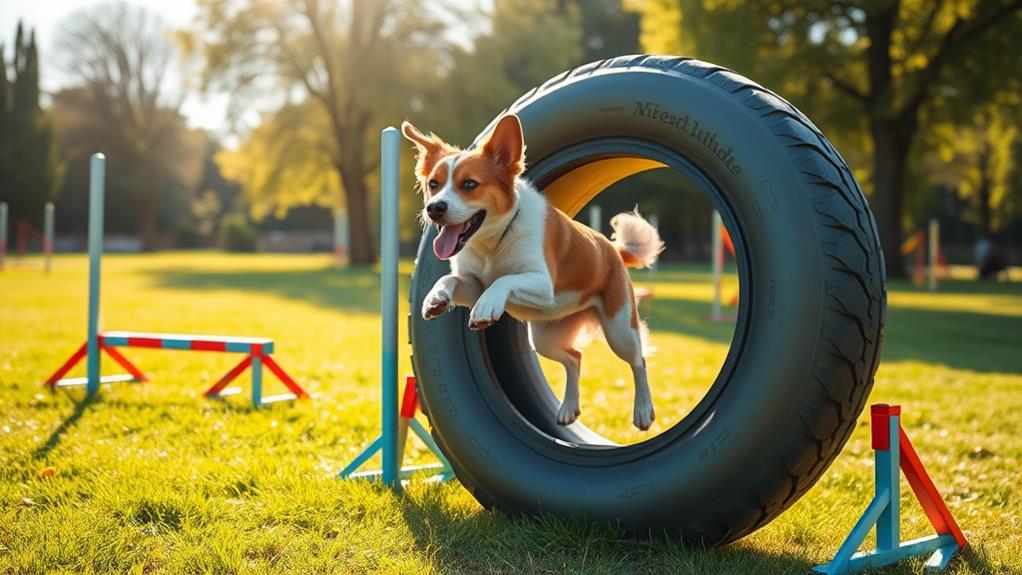
Once your pup has mastered the A-Frame climb, it's time to add some excitement with the Tire Jump. This fun exercise not only boosts your dog's agility skills but also builds their confidence.
You'll want to start with a low tire and gradually increase the height as your pup becomes more comfortable. Remember to use positive reinforcement, like treats and praise, to encourage them.
- Safety First: Guarantee the tire is stable and free from sharp edges.
- Clear Signals: Use a consistent command, like "jump," to help your pup understand what you expect.
- Practice Patience: Give your pup time to get used to the tire; don't rush them.
- Keep It Fun: Make the session enjoyable with plenty of breaks and playtime.
- Build Progressively: Start small and gradually increase the challenge as your pup gains confidence.
Balance Beams

Traversing balance beams is a fantastic way to enhance your pup's coordination and focus. These simple yet effective exercises help improve your dog's balance, which is essential for agility training. To start, find or create a sturdy beam that's low to the ground—this guarantees safety while your pup gets accustomed to the new challenge.
Introduce your pup to the beam gradually. Encourage them to walk across it using treats or their favorite toy as motivation. Make sure to praise your dog when they successfully navigate the beam; positive reinforcement goes a long way in building confidence. As your pup becomes more comfortable, you can increase the difficulty by adjusting the beam's height or length.
Keep sessions short and fun to maintain your dog's interest. Aim for three to five minutes at a time, gradually increasing the duration as they improve. Always supervise your pup to prevent any accidents. Remember, balance exercises can be challenging, so patience is key. With consistent practice, your pup won't only strengthen their body but also sharpen their mental focus, making them a more agile companion overall.
Spiral Course
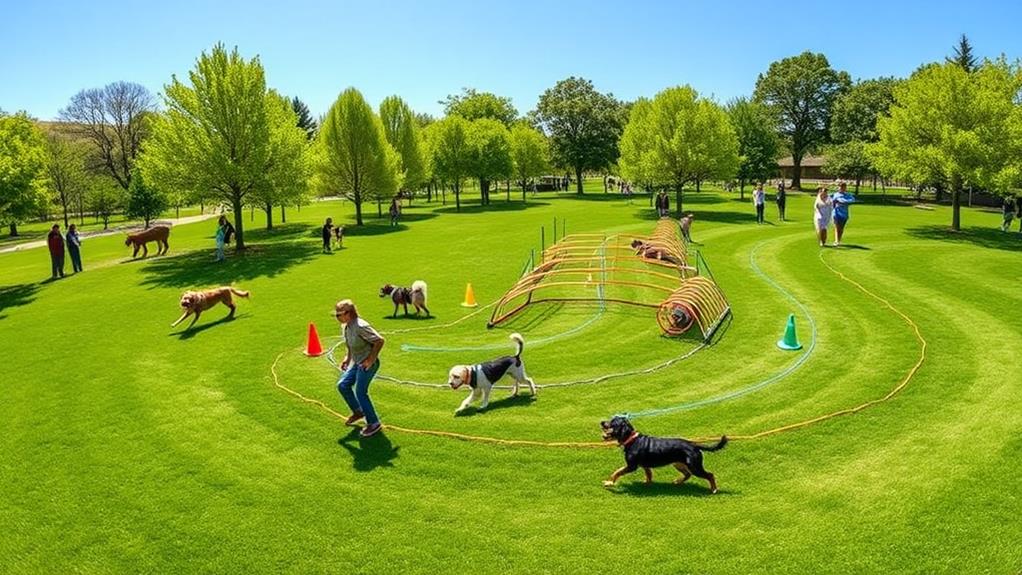
A spiral course can be an exciting way to improve your pup's agility and focus. This exercise challenges your dog to navigate a twisting path, helping them develop better coordination and mental sharpness.
By weaving in and out of cones or markers, your pup learns to control their speed and direction, enhancing their overall agility skills.
To set up a spiral course, follow these steps:
- Choose a safe space: Find an open area with enough room for your pup to maneuver comfortably.
- Use cones or markers: Set up a series of cones, gradually decreasing the distance between them as you create the spiral.
- Start slow: Encourage your dog to move through the course at a relaxed pace, gradually increasing speed as they gain confidence.
- Incorporate commands: Use verbal cues or hand signals to guide your pup, reinforcing communication skills.
- Reward progress: Celebrate your dog's achievements with treats and praise, building their enthusiasm for the exercise.
Pause Table
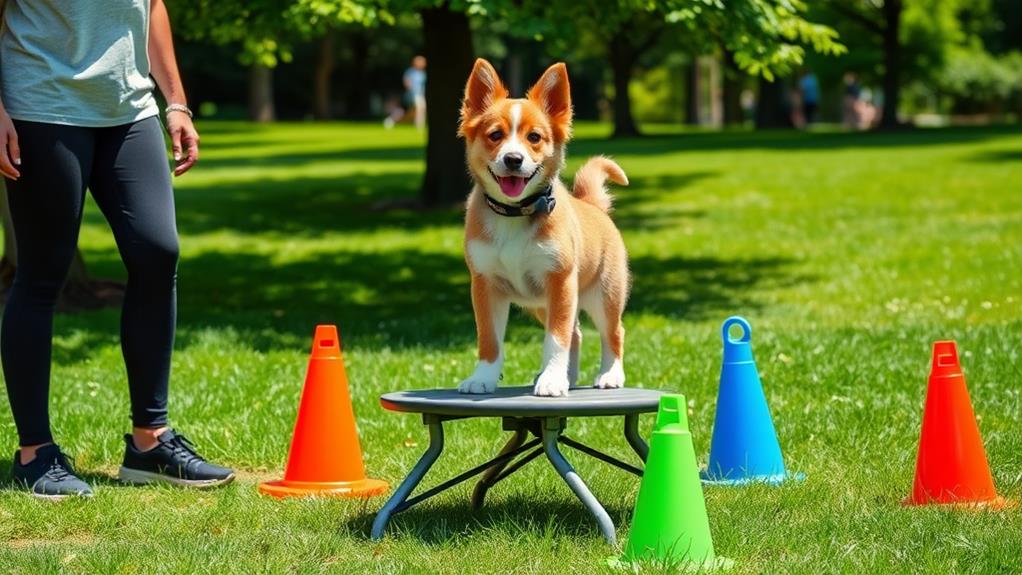
At the heart of agility training, the pause table offers a fantastic opportunity for your dog to practice focus and self-control. This exercise encourages your pup to learn how to pause and stay still, enhancing their overall performance in agility courses.
To start, position the table at a comfortable height for your dog. Introduce them to the table using treats or a favorite toy, encouraging them to jump onto it. Once your dog is on the table, give the command "stay" or "pause." Reward them for remaining still, reinforcing the importance of focus.
Gradually increase the duration they stay on the table before you reward them. Make sure to vary the duration and use different commands so your dog learns to anticipate your cues.
You can also introduce distractions, like a toy or another dog, to help your pup maintain their focus. This will greatly improve their impulse control. Remember to keep training sessions short and fun to maintain your dog's enthusiasm.
Incorporating the pause table into your agility routine won't only challenge your dog mentally but also strengthen your bond through teamwork.
Seesaw Training
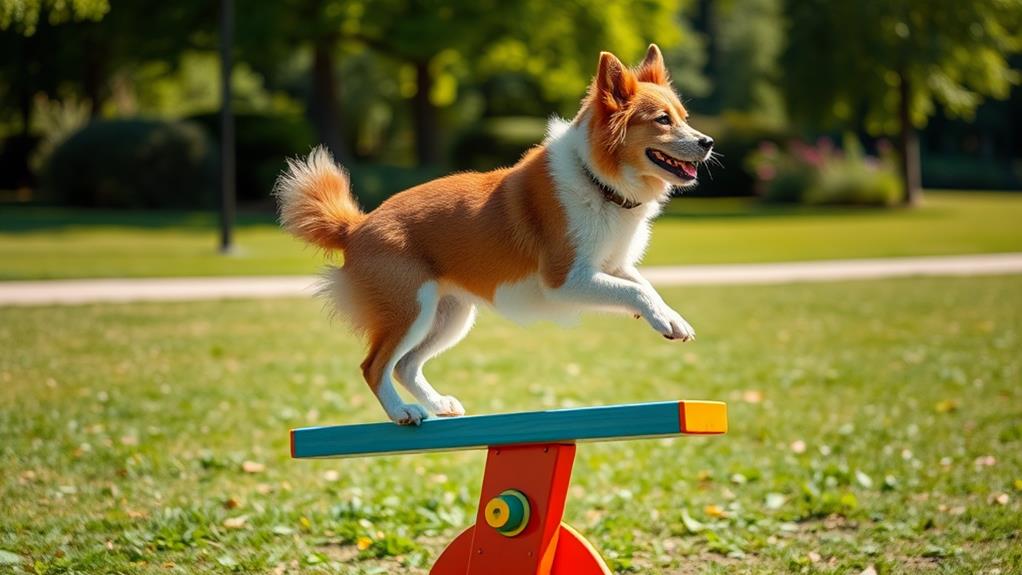
After mastering the pause table, it's time to introduce the seesaw, another exciting component of agility training. This challenge not only enhances your pup's balance and coordination but also builds their confidence.
When you first introduce the seesaw, keep it low to the ground. Gradually increase the height as your dog becomes more comfortable. Here are some tips to keep in mind during your seesaw training sessions:
- Start Slow: Allow your pup to explore the seesaw at their own pace.
- Use Treats: Positive reinforcement with treats helps encourage your dog to walk across the seesaw.
- Consistent Commands: Use the same command for getting on and off the seesaw to create clarity.
- Practice Regularly: Regular practice helps solidify the skill and boosts confidence.
- Stay Patient: Every dog learns at their own speed, so patience is key.
Incorporating seesaw training into your routine can turn agility exercises into a fun bonding experience. Keep your sessions upbeat and rewarding, and soon your pup will be traversing that seesaw like a pro!
Agility Ladder
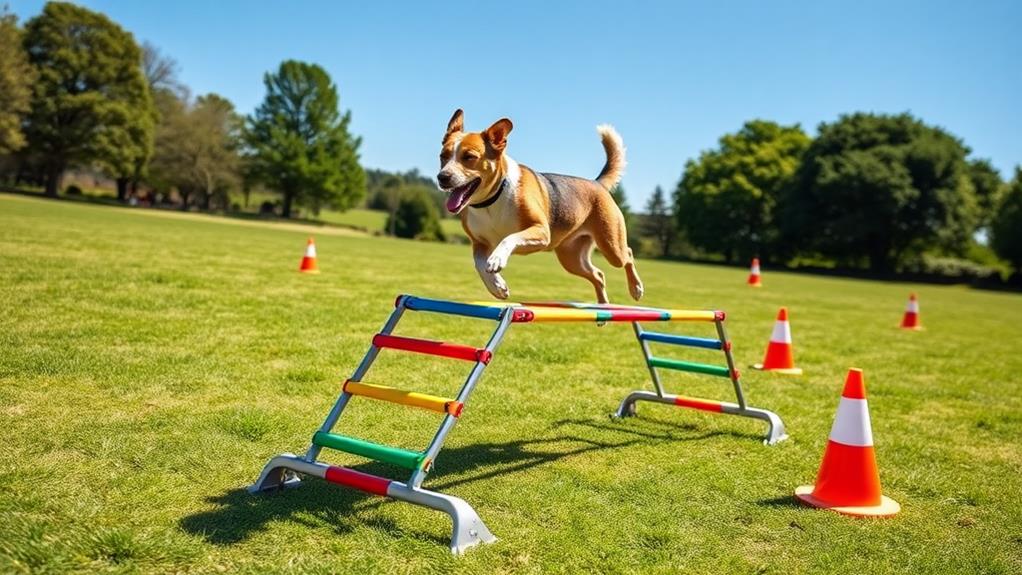
Incorporating an agility ladder into your training routine is a fantastic way to boost your pup's footwork and coordination. This simple yet effective tool can help improve your dog's speed, agility, and overall fitness. To get started, lay the ladder flat on the ground in a safe area where your pup can focus without distractions.
Begin with basic exercises, like having your pup step in and out of the rungs. Encourage them to go slowly at first, and gradually increase the speed as they become more comfortable. You can also incorporate commands like "jump" or "step" to reinforce training and keep your pup engaged.
As your dog becomes more adept, try adding variations such as lateral movements or diagonal steps. These not only challenge their coordination but also engage different muscle groups. Make sure to reward your pup with treats or praise to keep their motivation high.
Remember to keep sessions short and fun to prevent fatigue. With consistent practice, you'll notice your dog's footwork improving, leading to enhanced agility and overall performance in other activities. So grab that agility ladder and watch your pup thrive!
Frequently Asked Questions
How Often Should I Practice Agility Exercises With My Dog?
You should practice agility exercises with your dog at least two to three times a week. Consistency builds skills and strengthens your bond, but be sure to keep sessions fun and engaging to maintain enthusiasm.
What Age Is Appropriate for Starting Agility Training?
You can start agility training with your dog as early as six months old, but it's important to ascertain they've developed enough strength and coordination. Always consult your vet to determine the best age for your pup.
Can Agility Training Help With My Dog's Behavior Issues?
You might think agility training's just for competition, but it can really help with behavior issues. By channeling your dog's energy and focus, you'll see improvements in their obedience and overall demeanor during everyday activities.
What Should I Do if My Dog Is Scared of Agility Equipment?
If your dog's scared of agility equipment, start by introducing them slowly. Use treats and positive reinforcement to build confidence. Gradually expose them to each piece, ensuring they feel safe and comfortable throughout the process.
Are There Any Specific Breeds That Excel in Agility Training?
Certain breeds, like Border Collies and Australian Shepherds, naturally excel in agility training due to their intelligence and energy. However, with the right motivation and training, any dog can thrive in agility activities.
Conclusion
By incorporating these agility exercises into your pup's routine, you're not just building their physical skills but also strengthening your bond. Remember, training is like a time machine; it takes you both to a place of trust and teamwork. So grab that leash, set up your course, and watch your furry friend thrive. With consistent practice and plenty of love, you'll create memories that last a lifetime. Now, let the fun begin!



